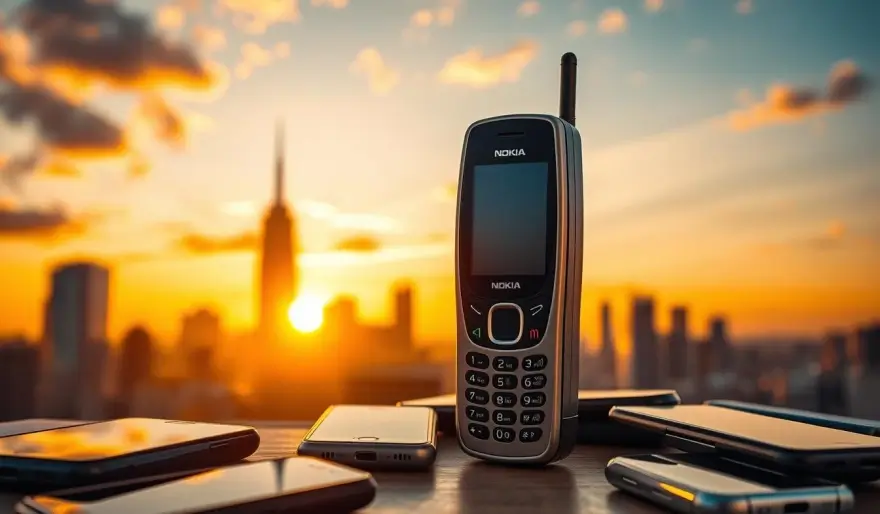Nokia: The Story of the Once-Legendary Phone Maker
40 min read Discover the remarkable journey of Nokia, from its humble beginnings to global phone dominance and eventual transformation. Learn how this tech pioneer shaped mobile history - written by shan kury, Content Creator October 25, 2024 10:28
Nokia has left a lasting mark on the tech world. Starting small in Finland, it grew into a global leader. It changed the mobile phone scene with its iconic devices and new ideas. This is Nokia's story from its early days to its peak as the top mobile phone brand.
Nokia began in the late 19th century as a paper mill in Finland. Over time, it grew and moved into electronics and communications. This big change helped Nokia become a leader in mobile phones.
Key Takeaways
- Nokia rose from a small Finnish paper mill to become a global telecommunications powerhouse.
- The company's transition to electronics and communications laid the foundation for its mobile phone dominance.
- Nokia's innovative products, such as the iconic Nokia 3310, transformed the mobile industry.
- The brand's golden era saw it achieve unparalleled global market leadership and brand recognition.
- Nokia's failure to adapt to the smartphone revolution ultimately led to its decline, but the brand has since undergone a resurgence.
The Origins of Nokia: From Paper Mill to Telecommunications Giant
Nokia started as a small paper mill in 1865 in Nokia, Finland. This simple start would grow into a global leader in telecommunications.
Early Industrial Roots in Finland
Nokia's early days were linked to Finland's industrial growth. It began as a paper mill but soon made rubber products, cables, and electronics. Leaders saw the chance in new technologies in the 20th century.
Transition to Electronics and Communications
In the 1960s, Nokia turned to electronics and telecom. It made TVs, radios, and more, setting the stage for mobile phones. This move was thanks to research and partnerships with big tech firms.
Key Founders and Visionaries
Leaders like Björn Westerlund led Nokia's change. Westerlund, CEO from 1977 to 1982, was key in Nokia's move to electronics and communications. He set the stage for Nokia's success.
Nokia's journey from a paper mill to a global telecommunications giant shows its ability to adapt and innovate. This Nokia history and its Finnish roots have greatly influenced the telecommunications evolution over a century.
The Rise to Mobile Phone Dominance in the 1990s
In the 1990s, Nokia became a mobile market leader. It reached new heights with 1990s technology and GSM phones. This rise made Nokia a global leader in mobile communications.
Nokia focused on the European market, where GSM phones were popular. Its early investment in 1990s technology helped it lead the European market. Nokia made high-quality, easy-to-use mobile devices.
- The iconic Nokia 1100, launched in 2003, became one of the best-selling mobile phones of all time, with over 250 million units sold worldwide.
- Nokia's pioneering work in mobile gaming, such as the popular Snake game, helped drive the widespread adoption of mobile entertainment.
- The company's innovation in camera phone technology, with the introduction of the Nokia 7650 in 2002, marked a significant milestone in the evolution of mobile photography.
By the late 1990s, Nokia was the mobile market leader, with over 30% of the global market. Its success came from focusing on users, cutting-edge tech, and a strong network.
"Nokia's success in the 1990s was a testament to its ability to anticipate and meet the evolving needs of mobile consumers around the world."
Nokia's rise in the 1990s set the stage for its future growth. It became a key player in the global telecommunications industry.
Nokia's Revolutionary Products That Changed Mobile Industry
Nokia is more than just a name in mobile phones. The Finnish company has changed the game with its innovative products. These have set new standards and led to the smartphones we use today. Let's look at some of Nokia's most groundbreaking creations.
The Indestructible Nokia 3310
The Nokia 3310 is a true legend. Introduced in 2000, it's known for its tough design and long battery life. It became famous for being almost unbreakable. The Snake game on it made it a cultural hit, loved by people all over the world.
Innovation in Mobile Gaming
Nokia made a big impact on mobile gaming. The Snake game on the Nokia 3310 and others started a gaming revolution. This simple game became a must-have on Nokia phones, offering endless fun for users.
Pioneering Camera Phones
Nokia was a leader in camera phones too. Their early work in camera phone technology led to the high-quality photos we take today. The Nokia 7650, released in 2001, was one of the first to have a built-in camera. It let users share their moments like never before.
| Product | Year Introduced | Key Features |
|---|---|---|
| Nokia 3310 | 2000 | Durable design, Snake game |
| Nokia 7650 | 2001 | Integrated camera, pioneering camera phone technology |
Nokia's products have made a lasting impact on the mobile world. They set new standards for durability, gaming, and photography. These innovations have shaped Nokia's legacy and helped create the smartphones we love today.
Nokia's Corporate Culture and Innovation Strategy
Nokia's quick rise to the top in the mobile phone world was thanks to its Finnish business culture and creative product making. Rooted in Finland, Nokia stood for teamwork, daring, and a never-ending quest for tech innovation.
The company's strong focus on R&D investment was a big reason for its success. Nokia spent a lot on research and development. This led to a culture of trying new things and pushing mobile tech to new heights. As a result, Nokia kept coming up with amazing products that won over people all over the world.
Nokia also made sure its employees felt valued. The company pushed them to think for themselves, take action, and share their ideas. This made Nokia's workers feel proud and eager to make the mobile world even better.
| Key Aspects of Nokia's Corporate Culture | Impact on Innovation and Success |
|---|---|
| Collaborative approach | Enabled cross-functional teams to synergize and create industry-leading products |
| Emphasis on R&D investment | Fueled the development of groundbreaking technologies and features |
| Employee empowerment | Encouraged a culture of experimentation and initiative-taking |
Nokia's special culture and way of innovating helped it become a top name in mobile phones. By following Finnish business culture, tech innovation, and R&D investment, Nokia made products that changed how people used mobiles everywhere.
The Golden Era: Nokia's Global Market Leadership
In the 1990s and early 2000s, Nokia was at the top of the mobile phone world. It focused on innovation, expanded globally, and built a strong brand. These efforts made it the clear leader in the market.
Peak Market Share Statistics
Nokia reached a peak with over 40% of the global market share. This showed it was the top name in mobile phones. It proved Nokia could meet the changing needs of people everywhere.
International Expansion Success
Nokia's smart move to expand globally was key to its success. It entered markets all over, using its tech and new products to win people's hearts. This global presence made Nokia's brand known and valued worldwide.
Brand Value and Recognition
Nokia's brand was known for quality, reliability, and innovation during its best years. Its designs and features won people's trust. This loyalty made Nokia the top choice for mobile needs globally.
"Nokia's ability to consistently deliver high-quality, innovative products that met the evolving needs of consumers worldwide was the driving force behind its unparalleled market dominance and global expansion during its golden era."
The iPhone Effect: Missing the Smartphone Revolution
The smartphone era brought a big change to the mobile world. Nokia, once a top phone maker, had trouble keeping up. Apple's iPhone changed the game with its touch screen and easy use, leaving Nokia behind.
Nokia was known for durable phones, but it didn't keep up with the iPhone's new style. It stuck to old phones and didn't jump into the smartphone disruption fast enough.
As Apple competition grew, Nokia's share of the market fell. Nokia couldn't guess what customers wanted next. This showed how staying the same can hurt in a world that always changes.
| Metric | Nokia | Apple |
|---|---|---|
| Global Smartphone Market Share (2007) | 50.9% | 0% |
| Global Smartphone Market Share (2011) | 19.9% | 18.8% |
The iPhone effect showed how one new product can change an entire industry. Nokia's story warns businesses to always be ready to change and meet customer needs.
"Nokia was once the undisputed king of the mobile phone world, but it failed to anticipate the rapid rise of the smartphone and the disruption it would bring to the industry."
Nokia's fall teaches us that even big leaders can fall behind in tech. As the mobile world keeps changing, Nokia's story is a key lesson for companies wanting to stay ahead.
Microsoft Acquisition and Windows Phone Partnership
In 2013, Microsoft bought Nokia's mobile division for $7.2 billion. This move was a big change in the tech world. It was aimed at making Microsoft stronger in the mobile OS market, where Android and iOS were leaders.
Deal Structure and Terms
The deal included Nokia's Devices & Services business and the rights to the Nokia brand for phones and tablets. Microsoft also got Nokia's patents and licenses. This made Microsoft's intellectual property stronger in mobile.
Integration Challenges
Putting Nokia's mobile division into Microsoft's operations was hard. It took time to mix their cultures, align plans, and fix supply chains. Microsoft also had to cut jobs to make things work better.
Market Performance
The partnership between Microsoft and Nokia faced tough competition in the mobile OS market. Even with Nokia's hardware and Microsoft's software, Windows Phone couldn't beat Android and iOS. This led to the end of the partnership in 2016.
"The acquisition of Nokia's Devices and Services business allows Microsoft to accelerate the growth of its share and profits in mobile devices." - Steve Ballmer, former Microsoft CEO
Brand Revival: HMD Global and Android Adoption
Nokia's iconic brand has made a stunning comeback, thanks to HMD Global. This Finnish company has brought new life to Nokia, focusing on Android phones for many users.
The HMD Global partnership has been a turning point for Nokia. It has allowed Nokia to stand strong in the competitive mobile world. Nokia now offers a range of smartphones, blending the classic Nokia feel with modern tech.
Nokia has found the right mix of new and old. Its Android devices pay homage to classic Nokia phones like the Nokia 3310. Yet, they also bring in fresh design and advanced technology.
| Metric | Value |
|---|---|
| Global smartphone market share (2021) | 1.1% |
| Number of countries with Nokia Android phones | 80+ |
| Projected growth in Nokia smartphone sales (2022-2023) | 15-20% |
The partnership with HMD Global has helped Nokia target specific markets and users. Nokia now offers a wide range of Android phones for various budgets and tastes. This strategy has helped Nokia grow in both developed and emerging markets.
Nokia is on a strong path with its renewed brand and Android phone lineup. With a focus on innovation, quality, and customer happiness, Nokia aims to regain its place in the mobile world.
Nokia's Impact on Modern Telecommunications
Nokia has been a leader in the telecommunications world. It has shaped how we connect today. From its network solutions to its work on 5G, Nokia has made a big impact.
Network Infrastructure Legacy
Nokia is known for building strong and reliable networks. These networks help information flow smoothly around the world. Nokia's work in mobile and fixed broadband has helped connect many countries.
Nokia is all about innovation and quality. It's a go-to partner for network operators and service providers everywhere.
5G Technology Development
Nokia is leading the 5G revolution. It's a key player in making 5G networks a reality. Nokia's research has made 5G faster, more reliable, and more connected.
Nokia's Nokia networks are at the center of many 5G projects. This shows Nokia's role in modern telecommunications.
| Key Milestones | Nokia's Contributions |
|---|---|
| Network Infrastructure | Pioneered reliable and scalable telecommunications networks |
| 5G Technology | Played a leading role in the development and deployment of 5G networks |
| Global Reach | Expanded its reach and impact across numerous countries and regions |
Nokia's lasting impact in telecommunications shows its innovative spirit. As technology keeps changing, Nokia's legacy will keep shaping our future.
Learning from Nokia's Business Transformation
Nokia's journey from a paper mill to a global leader in telecoms is a lesson for all. It shows how important it is to adapt quickly to new tech. Nokia's story teaches us about staying ahead and being resilient in the face of change.
One big lesson is the need for businesses to be agile. Nokia failed to keep up with the smartphone era, a warning for any company. It's crucial to watch the market, spot trends, and change strategies to stay ahead.
Nokia also shows the power of innovation and taking risks. Its early success came from trying new things and embracing new tech. But when Nokia was slow to innovate, it lost its lead. Companies should create a culture that supports risk and innovation to stay ahead.
FAQ
What were the early industrial roots of Nokia in Finland?
Nokia began as a paper mill in Finland. It then moved into electronics and telecommunications. This move made it a top player in mobile phones worldwide.
How did Nokia rise to mobile phone dominance in the 1990s?
Nokia quickly became a leader in mobile phones in the 1990s. This was thanks to new products and tech innovations. Especially in GSM phones, which helped the company lead the market.
What were some of Nokia's most revolutionary products that changed the mobile industry?
Nokia's key products included the Nokia 3310 and Snake. They also introduced camera phones, changing mobile photography forever.
How did Nokia's corporate culture and innovation strategy contribute to its success?
Nokia's success came from its unique culture and innovation. Its focus on research and empowering employees helped it lead the mobile industry.
What were the key factors behind Nokia's golden era of global market leadership?
Nokia's golden era was marked by huge market share and global expansion. It built a strong brand, becoming the top mobile phone player.
Why did Nokia struggle to adapt to the smartphone revolution led by the iPhone?
Nokia couldn't quickly adapt to the iPhone and touchscreen tech. This led to a decline in market share, as it couldn't keep up with smartphones.
How did the Microsoft acquisition and Windows Phone partnership impact Nokia's mobile business?
The Microsoft deal and Windows Phone partnership faced challenges. They didn't gain much market share, adding to Nokia's struggles in the smartphone era.
How has Nokia's brand been revived under HMD Global and the shift to Android smartphones?
Nokia's brand has been revived under HMD Global. It now focuses on Android smartphones, aiming to regain its market share.
What is Nokia's ongoing impact on modern telecommunications?
Nokia still influences the telecom industry. It's known for its network infrastructure and 5G tech leadership.
What key lessons can be learned from Nokia's business transformation?
Nokia's story teaches the value of adaptability and resilience in tech. It shows how to navigate fast-changing markets, offering lessons for businesses.
User Comments (0)
Popular Apps










Editor's Choice









